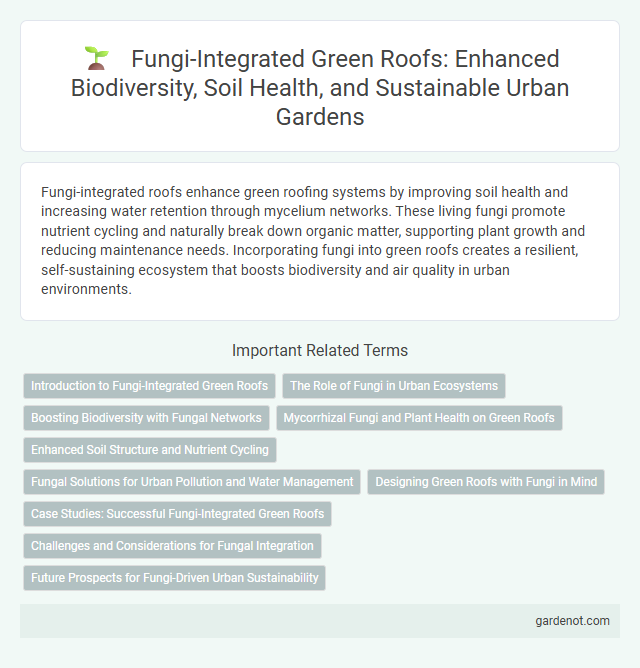Fungi-integrated roofs enhance green roofing systems by improving soil health and increasing water retention through mycelium networks. These living fungi promote nutrient cycling and naturally break down organic matter, supporting plant growth and reducing maintenance needs. Incorporating fungi into green roofs creates a resilient, self-sustaining ecosystem that boosts biodiversity and air quality in urban environments.
Introduction to Fungi-Integrated Green Roofs
Fungi-integrated green roofs incorporate mycorrhizal fungi that enhance plant nutrient absorption and soil health, promoting sustainable urban ecosystems. These fungi form symbiotic relationships with plant roots, improving water retention and resilience against environmental stress. Implementing fungi-enriched substrates supports biodiversity while optimizing the green roof's ecological performance and longevity.
The Role of Fungi in Urban Ecosystems
Fungi play a crucial role in urban ecosystems by enhancing nutrient cycling and improving soil health on fungi-integrated green roofs. Their mycelium networks facilitate organic matter decomposition, promoting plant growth and increasing biodiversity in densely built environments. By supporting microbial communities and aiding in pollutant breakdown, fungi contribute to sustainable urban green infrastructure and resilience against environmental stressors.
Boosting Biodiversity with Fungal Networks
Fungi-integrated green roofs enhance biodiversity by establishing complex mycorrhizal networks that facilitate nutrient exchange and improve soil health. These fungal networks support plant growth, increase resilience to environmental stressors, and create habitats for diverse microorganisms and invertebrates. Incorporating mycorrhizal fungi into green roof substrates promotes ecosystem stability and boosts urban ecological connectivity.
Mycorrhizal Fungi and Plant Health on Green Roofs
Mycorrhizal fungi form symbiotic relationships with plant roots on green roofs, enhancing nutrient uptake and improving plant health. These fungi increase soil structure stability, water retention, and stress resilience, essential for thriving vegetation in rooftop environments. Integrating mycorrhizal inoculants into green roof substrates promotes sustainable plant growth and ecosystem functionality.
Enhanced Soil Structure and Nutrient Cycling
Fungi-integrated green roofs significantly improve soil structure by forming extensive mycelial networks that bind soil particles, enhancing aeration and water retention. These networks accelerate nutrient cycling by decomposing organic matter and facilitating symbiotic relationships with plants, which boosts nutrient availability and uptake. Enhanced microbial activity promoted by fungi leads to healthier vegetation and increased resilience of green roof ecosystems.
Fungal Solutions for Urban Pollution and Water Management
Fungi-integrated green roofs leverage mycelium networks to enhance urban pollution mitigation by breaking down airborne toxins and heavy metals, improving air quality in densely populated areas. These fungal systems contribute to efficient water management by increasing soil moisture retention and facilitating the biodegradation of contaminants in rainwater runoff. Implementing fungal solutions in green roofs supports sustainable urban ecosystems, reduces environmental pollutants, and promotes healthier hydrological cycles.
Designing Green Roofs with Fungi in Mind
Designing green roofs with fungi integration enhances soil health by promoting mycorrhizal networks that improve nutrient absorption and water retention. Incorporating fungi species such as arbuscular mycorrhizal fungi supports plant resilience and growth, optimizing the overall ecosystem balance. Selecting substrates that foster fungal colonization ensures durable root systems and sustainable green roof performance.
Case Studies: Successful Fungi-Integrated Green Roofs
Case studies of fungi-integrated green roofs demonstrate enhanced soil health, improved moisture retention, and increased plant biodiversity through mycorrhizal symbiosis. Projects such as the MIT Media Lab's green roof and the Vancouver Convention Centre highlight significant carbon sequestration and stormwater management benefits. These successful implementations underscore fungi's role in stabilizing substrates and boosting overall ecosystem resilience in urban environments.
Challenges and Considerations for Fungal Integration
Fungi-integrated green roofs require careful consideration of substrate composition, moisture retention, and microclimate to support fungal growth while maintaining plant health. Challenges include balancing mycelium colonization with structural integrity, managing potential pathogenic risks, and ensuring compatibility with existing roof materials. Effective fungal integration demands ongoing monitoring for environmental conditions, nutrient availability, and symbiotic relationships to optimize ecosystem benefits.
Future Prospects for Fungi-Driven Urban Sustainability
Fungi-integrated green roofs offer promising advancements for urban sustainability by enhancing nutrient cycling, improving soil health, and increasing structural resilience. Mycorrhizal fungi symbiotically support plant growth, reducing the need for chemical fertilizers and promoting biodiversity in urban environments. Future developments in fungal biotechnology could optimize carbon sequestration and water retention on rooftops, contributing significantly to climate change mitigation and urban ecosystem restoration.
Fungi-integrated roof Infographic

 gardenot.com
gardenot.com